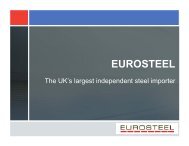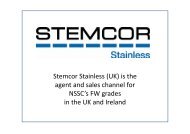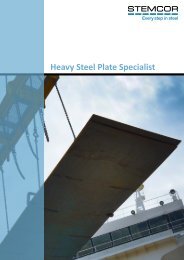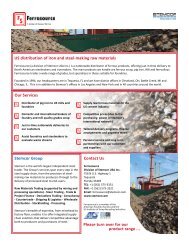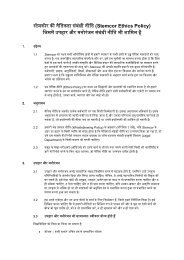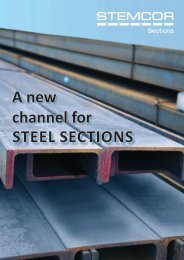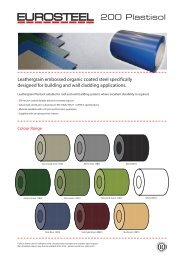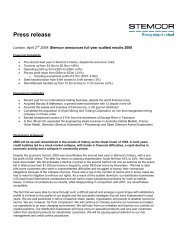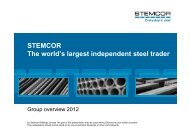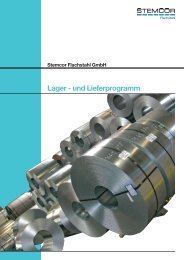You also want an ePaper? Increase the reach of your titles
YUMPU automatically turns print PDFs into web optimized ePapers that Google loves.
<strong>Press</strong> <strong>release</strong><br />
London, April 9th 2008: <strong>Stemcor</strong> announces full year results 2007<br />
Highlights<br />
Record turnover and tonnage:<br />
• Turnover up from £3,308m to £ 4,254m (+29%)<br />
• Operating profit up from £79m to £92m (+16%)<br />
• Pre-tax profit up from £52m to £65m (+27%)<br />
o Exceptional profit £16m (2006: nil)<br />
• Steel up from 9.4m tonnes to 9.8m tonnes (+3%)<br />
• Raw materials up from 9.5m tonnes to 10.5m tonnes (+11%)<br />
Salient points:<br />
• Achieved over 40% growth in tonnage sold in Continental Europe.<br />
• Acquired international stockholder Steel Plate & Sections (SPS).<br />
• Divested Savage River iron ore operations in Tasmania, retaining 10% stake.<br />
• Invested in iron ore mining and pelletisation operations in India.<br />
• Launched <strong>Stemcor</strong> Risk Management to use the new steel futures exchanges to manage price<br />
risk both for <strong>Stemcor</strong> and for our partners.<br />
• Strong prospects for 2008, with solid forward order book.<br />
• In March 2008, acquired UK stockholder Barclay & Mathieson.<br />
Chairman's statement<br />
It is pleasing to be able to report another successful year, both in terms of results and strategic<br />
progress. The underlying numbers are not as good as the headline figures, because of the<br />
exceptional capital gains booked during the year. This was, however, a record performance.<br />
We again earned an after-tax return of over 40% on shareholders’ funds at the beginning of<br />
the year. Most of this return is retained within the company and our shareholders funds are<br />
£150 million.<br />
Our growth in recent years has resulted from our ability to adapt to a changing world by reinventing<br />
ourselves through new strategies. One such important strategy has been to go downstream and<br />
provide more value-added services, including holding stock for quick or just-in-time delivery and<br />
processing prior to delivery. In Germany, our distribution, stockholding and processing subsidiaries -<br />
OKS, S+B Flachstahl and WSK - hold planned stocks in 12 different locations. In the USA, 2007<br />
was the first full year of ownership of our stockholding subsidiary, Kenilworth, in Warren, Ohio and
we also hold stocks at a number of port locations. In France, Italy and Central Europe, our fast<br />
expanding businesses now hold unsold stocks at various ports, as we have done for many years in the<br />
UK. In 2007 we purchased a well established steel stockholder and processor, SPS, which is<br />
headquartered in Birmingham, England, but has an international business with special focus on the<br />
offshore oil and gas industry. SPS holds stock in Birmingham, Glasgow, Rotterdam, Dubai and<br />
Singapore. We are planning further acquisitions and, although we fully intend to go global in<br />
stockholding, we believe this will be more easily accomplished by initially building up a strong base<br />
in the developed world. With this in mind we have just completed the acquisition of Barclay &<br />
Mathieson, a general steel stockholding group with 12 depots in the UK.<br />
We monitor and control the level of unsold stocks very closely and every unit has to operate within<br />
limits set by our risk director. Our unsold stocks amount to just 3% of the total steel tonnage we sell<br />
annually. We focus on the length of time material has been in stock to ensure minimum stock levels<br />
with maximum stock-turns. Any stock that is more than six months old is subject to obsolescence<br />
provisions, which are among the more conservative in the industry. This also serves to motivate our<br />
unit managers to ensure that our stock really does turn over quickly.<br />
Prices that go up can also come down. Stockholders benefit from stock appreciation in a rising<br />
market but, even if they are skilled in controlling stock levels and anticipating price movements, they<br />
will still suffer when prices fall. This price risk has been difficult to avoid in the absence of a futures<br />
market and is one of the many reasons that we welcome the introduction of steel futures at the LME<br />
and other futures exchanges. We look forward to being able to hedge at least part of our price risk on<br />
our own steel stocks through futures markets. Steel futures will take time to become generally<br />
accepted but we are confident that they will take hold and have major implications for our industry.<br />
Apart from the ability to hedge trading positions we believe that more and more sales in future will<br />
be linked to exchange prices. We are exploring further activities we could undertake in the new<br />
world of steel futures and we have set up a specialist team for this purpose.<br />
2007 was a very strong year for steel trading. The unprecedented rise in the cost of freight, however,<br />
did have a substantial negative effect on our profitability. We do hedge our freight exposure as<br />
appropriate, but it is often not possible to do so effectively. Volatility in our markets is becoming<br />
more pronounced and increasingly it will become necessary for a steel trading company to hedge its<br />
risk exposure both to steel and to freight prices.<br />
Raw materials also saw strong growth in 2007. The disposal of the majority of our holding in Savage<br />
River in Australia might look premature in view of the recently announced steep rise in iron ore<br />
pricing, but we are re-investing the proceeds into iron ore projects in Orissa in India, where we<br />
believe we can obtain a better long-term return.<br />
Our portfolio today extends beyond traditional trading into financial services. One example was our<br />
advisory role in the successful restructuring and privatisation of the Georgian ferro-manganese<br />
industry. This was a transaction that any investment bank would have been proud to accomplish. Our<br />
fee-based consultancy services in offset also had a good year.<br />
Overall, 2007 was a mixed year for the global steel industry as the arrival of increased Chinese<br />
exports affected prices in the second half, despite the world-wide construction boom and the growth<br />
in world steel consumption. At the beginning of 2008 clear evidence that China was intent on<br />
controlling and reducing steel exports started an upward spike in steel prices, which is continuing as<br />
I write, and which has been described by one commentator as a price volcano. Other commentators
are suggesting that without Chinese exports the rest of the world now faces a structural shortage in<br />
steel capacity, which will further fuel the rise in prices we have experienced in the first quarter.<br />
Never has there been a more striking contrast or disconnect between the financial world with its<br />
credit problems and the real world of steel with its apparent growing demand. The question is how<br />
much longer can these two different worlds inhabit the same universe? The past history of the steel<br />
industry suggests that prices will not go on climbing for ever and the bigger the rise, the greater the<br />
risk of a correction. If the credit crisis continues, it will reduce both the purchase of consumer<br />
durables like cars and requirements for new retail and commercial construction. There will be an<br />
adverse impact on investment in general and therefore on the demand for steel. We therefore retain a<br />
healthy caution about what the future may bring. As far as our own prospects are concerned, we are<br />
confident that we have put in place the building blocks for continued success. We expect further<br />
growth and another good year in 2008, based on strong current trading and our substantial forward<br />
order book.<br />
My thanks again to our customers, our suppliers and our bankers for their continued support and to<br />
our dedicated staff for all their hard work. We look forward to our future together with confidence.<br />
Ralph Oppenheimer<br />
Executive Chairman<br />
4 th April 2008<br />
Editors’ notes<br />
Consolidated profit and loss account<br />
For the year ended 31 December 2007<br />
Ends<br />
Year to Year to<br />
31/12/2007 31/12/2006<br />
£'m £'m<br />
Turnover 4,254 3,308<br />
Cost of sales (4,075) (3,157)<br />
Gross Profit 179 151<br />
Distribution costs and administrative expenses (87) (72)<br />
Operating profit 92 79<br />
Exceptional Items 16<br />
Net interest payable (43) (28)<br />
Profit on ordinary activities before tax 65 52<br />
Taxation (20) (15)<br />
Profit on ordinary activities after tax 45 37<br />
Minority Interests (1) (4)<br />
Profit attributable to shareholders 44 33
Consolidated balance sheet<br />
31 December 2007<br />
31/12/2007 31/12/06<br />
£'m £'m<br />
Fixed assets 40 47<br />
Current assets<br />
Stocks 417 317<br />
Debtors 821 575<br />
Cash at bank and in hand 169 77<br />
1,406 969<br />
Creditors: amounts falling due within one year<br />
Bank loans and overdrafts (848) (520)<br />
Creditors and accruals (397) (340)<br />
(1,245) (860)<br />
Net current assets 161 109<br />
Total assets less current liabilities 201 156<br />
Creditors: amounts falling due after more than one<br />
year (51) (51)<br />
Net assets 150 105<br />
Shareholders' funds 150 102<br />
Minority interests 0 3<br />
Total equity 150 105<br />
All the financial information set out above is extracted from the audited financial statements of<br />
<strong>Stemcor</strong> Holdings Limited.<br />
<strong>Stemcor</strong> profile<br />
<strong>Stemcor</strong> is the world’s largest independent steel trader.<br />
<strong>Stemcor</strong> plays a pivotal role in the steel industry, acting as a trading intermediary between producers<br />
and purchasers and providing a range of associated services. Steel goods traded include a wide range<br />
of long, flat, tube and semi-finished products. Raw materials for the production of steel include iron<br />
ore, pig iron, coal, coke, ferroalloys and scrap.<br />
<strong>Stemcor</strong> now employs more than 1,000 people in its network of 70 offices in 40 countries across the<br />
globe. For the financial year ending 31 December 2007, <strong>Stemcor</strong> traded 20.2 million tonnes of steel<br />
and associated raw materials, with turnover of £4.2 billion (US$8.5 billion).
<strong>Stemcor</strong>’s services span every step in the steel supply chain, from the provision of steel-making raw<br />
materials to producers through to the delivery of processed steel to end-users. The company’s core<br />
competencies - steel trading, raw materials trading, distribution, stockholding and finance - are<br />
interlinked and apply to all its business units across the world. <strong>Stemcor</strong>’s breadth of expertise affords<br />
a unique perspective, enabling it to offer integrated solutions that improve its partners’ business<br />
performance.<br />
<strong>Stemcor</strong> does not own any steel mill, nor is any mill a shareholder in the company. This<br />
independence ensures that it is objective in matching exact customer needs in terms of quality,<br />
specifications, financial terms and delivery.<br />
<strong>Stemcor</strong> was formed in London in 1951 and is a privately owned company. The majority of shares<br />
are held by the Oppenheimer family, represented by Ralph Oppenheimer (Executive Chairman) and<br />
Philip Edmonds (Deputy Chairman), with the balance of shares held by employees. The company<br />
prides itself on the quality of its people, its risk management and its track record.<br />
Trading names: Barclay + Mathieson, Eurosteel, Kenilworth, L.W. Lambourn, OKS Otto Knauf,<br />
Samac, Schmolz + Bickenbach Flachstahl, SPS, <strong>Stemcor</strong>, Uldry Trading, WSK.<br />
Contact<br />
Patrick Pearson<br />
Head of Communications<br />
<strong>Stemcor</strong> Holdings Limited<br />
Level 27, CityPoint<br />
1 Ropemaker Street<br />
London EC2Y 9ST<br />
Direct tel: +44 (0)207 7753594<br />
Email: patrick.pearson@uk.stemcor.com



